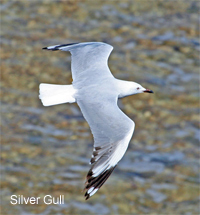| |
| Home |
| Activities Calendar |
| Birding Sites |
| Newsletter Archive |
| Recent Outings |
| Photography Group |
| Contact Us |
| Point Cook Coastal Park |
|
Access: Point Cook Road (Map 207 Grid K12) and Point Cook Homestead Road (Map 199 Grid J1) for Homestead Facilities: Parking, toilets, bird hide at Spectacle Lake, BBQ’s, partial wheelchair access, café Habitat: Point Cook is a low rainfall area and the soil has a relatively high salt content. The natural vegetation at the time of European arrival comprised scattered clumps of trees, grasses and shrubs, frequently burned by the Aboriginal inhabitants. Extensive areas of saltmarsh vegetation grew in wetter areas close to the coast. There was a band of bush, probably wattles and shrub species, inland from the beach. This was known as the Point Cook Forest and was felled as the area was settled. The present day vegetation of the Point Cook Coastal Park is largely remnant basalt plains grassland, with areas of coastal salt marsh, grassy wetland and sedgeland. There are several natural waterbodies in the park supporting aquatic species. A notable plant found on the shores of the highly saline RAAF Lake is the Chaffy Saw-sedge, which provides habitat for the rare Altona Skipper Butterfly. Selected sites in the park are now being planted with trees grown from seed collected from remaining natural specimens. Park Notes & Map: Click here The north east boundary of Point Cook Coastal Park is a common boundary with Cheetham Wetlands. The historic bluestone homestead and café is open at weekends. Homestead History: Click here Typical Common Birds include: Black Swan; Crested Pigeon; Little Pied Cormorant; Pied Cormorant; Straw-necked Ibis; Brown Falcon; Masked Lapwing; Pacific Gull; Silver Gull; Superb Fairy-wren; Yellow-rumped Thornbill; Singing Honeyeater; White-plumed Honeyeater; Red Wattlebird; White-fronted Chat; New Holland Honeyeater; Australian Magpie; Willie Wagtail; Little Raven; Magpie-lark; Eurasian Skylark; Welcome Swallow; Common Starling; House Sparrow; European Goldfinch. Other Possible Birds include: Brown Quail; Australian Shelduck; Grey Teal; Chestnut Teal; Pacific Black Duck; Hardhead; Australasian Grebe; Hoary-headed Grebe; Rock Dove; Spotted Dove; Australasian Gannet; Great Cormorant; Little Black Cormorant; Australian Pelican; White-faced Heron; Australian White Ibis; Black-shouldered Kite; Swamp Harrier; Little Eagle; Nankeen Kestrel; Australian Hobby; Black-winged Stilt; Common Greenshank; Marsh Sandpiper; Red-necked Stint; Sharp-tailed Sandpiper; Crested Tern; Galah; Horsfield’s Bronze-Cuckoo; Fan-tailed Cuckoo; Little Wattlebird; Black-faced Cuckoo-shrike; Flame Robin; Golden-headed Cisticola; Silvereye; Common Blackbird; Common Myna; Australasian Pipit; Common Greenfinch. Outings Bird Lists: For a Bird List of all recent BirdLife Melbourne Outings to this site, click here
|
|
||


